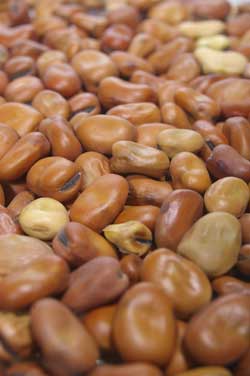

Photo by Judith Hausman
Who knew I would learn so much from fava beans?
Last Thursday, my garden co-op harvested our entire aphid-attracting fava-bean crop. We pulled up all the bushes, which had bent under the weight of the bumpy green pods, piled them into a wheelbarrow, and trundled them over to a shady spot behind the garden house. Six of us stripped the fava bean pods, divvied them up roughly into 10 large bagfuls (to include the absent members), and wheeled the waste to the compost pile.
Then, once in the kitchen, we each had more to do before we could enjoy the fava beans: opening the tough pods; rinsing and cooking the beans briefly; and draining, cooling and then popping each of them out of their second skin. My own bagful resulted in about 2 1/2 quarts, I think.
Here’s the thing: When and if you find fava beans in the supermarket, the pods are a smooth and sleek green and there are piles and piles of them. You can also buy frozen peeled and dried fava beans, too. As my hands got blacker and blacker from opening my brown-spotted share during the first round, I kept thinking about what would have to be done to a fava-bean crop to make them so grocery-store “perfect.” What goes into growing and prepping so, so many of the beans?
This is a sobering, if not obvious, thought I frequently have when I’m harvesting my vegetables or buying organic ones at the farmers market.
A fennel bulb is really about one-third the size of a supermarket fennel bulb; the central head of a real Savoy cabbage is not the size of a soccer ball; a real strawberry lasts about two days; fava beans are often brown or black-spotted … and take a lot of prep work.
I can’t even imagine what it takes to have as many shrimp that chain restaurants do, as much roast beef fast-food sandwiches contain, or as many drumsticks you-know-which Colonel has. If you want to see this graphically, check out the documentaries “Food, Inc.,” and “Food Matters.”
The hopeful lesson I can take from my fava beans, along with making the most wonderful salads when topped with shaved Parmesan and thin-sliced fennel or chopped tomatoes, mint and red onion, is a deeper appreciation for this vegetable. To me, it is a delicacy, but it is almost a staff of life in many Middle Eastern countries. It takes a lot of work to grow and prepare it to eat. It must take acres and acres to grow as many as humans need.
The favas aren’t pristine and naturally bright; some interventions I’m probably uneasy with happen to make them so. What’s more, it’s likely most of what I eat undergoes similar interventions to not only keep the food pretty but also to feed our multiplying population, sometimes not so well, unfortunately.
This lesson also makes me feel the deep privilege of being able to grow food in the suburbs; of working hard and gardening with dedicated friends; of raving over the squash or the fava crop and harvesting as a group, wise-cracking and trading recipes with the lovely lull of chortling turkeys, satisfied chickens and peeping guinea fowl.




